Mechanical Properties and Fracture Behavior of an EBW T2 Copper–45 Steel Joint
Abstract
1. Introduction
2. Materials and Methods
2.1. Preparation of the T2 Copper–45 Steel Joint
2.2. Tensile Test and SPT Procedure
2.3. Numerical Simulation
3. Results and Discussion
3.1. Analysis of the Tensile Test and SPT
- Zone I: Elastic bending;
- Zone II: The transition between elastic and plastic bending;
- Zone III: Plastic hardening;
- Zone IV: Softening due to material damage initiation;
- Zone V: Crack growth with a circular shape around the center of the specimen until failure.
3.2. Analysis of Fracture Behavior
3.3. SPT Simulation
4. Conclusions
- (1)
- Based on the tensile test, the ultimate strength of the T2 copper–45 steel joint was determined to be 267.54 MPa, the yield strength was 240.93 MPa, and the Young’s modulus was 174.28 GPa. The fracture toughness was then determined to be 210.827 KJ·m−2 using SPT.
- (2)
- The tensile test showed that the fracture was located in the copper-side HAZ because the thermal conductivity of copper is much higher than that of steel, which implied a large amount of heat being biased on the copper side during the welding process. Therefore, the grain became too coarse and resulted in the copper-side HAZ being the weakest joint region. With the future development of deformation, the specimen ended with apparent necking.
- (3)
- SPT at room temperature showed that the cracks were first generated by microvoid nucleation and cavity growth. While a macrocrack was formed, a secondary crack also appeared on the opposite side. After SPT was completed, the sign of the Erichsen shape and the outgrowth could be seen on the surface of the specimen intuitively. The appearance of slip-band indicated the offset between the initial accumulation of damage and the initial crack region. Moreover, the fracture types of the specimen were found to be cleavage fracture and ductile fracture, as determined via SEM. Based on theoretical and ABAQUS analyses, it was concluded that the crack first appeared in the copper-side HAZ, and the deflection was controlled by the toughness difference.
Author Contributions
Funding
Conflicts of Interest
References
- Zhou, X.; Duan, J.; Zhang, F.; Zhong, S. The Study on Mechanical Strength of Titanium-Aluminum Dissimilar Butt Joints by Laser Welding-Brazing Process. Materials 2019, 12, 712. [Google Scholar] [CrossRef] [PubMed]
- Yang, C.H.W.; Jiang, S.H.J. Weibull statistical analysis of strength fluctuation for failure prediction and structural durability of friction stir welded Al–Cu dissimilar joints correlated to metallurgical bonded characteristics. Materials 2019, 12, 205. [Google Scholar]
- Shiri, S.G.; Nazarzadeh, M.; Sharifitabar, M.; Afarani, M.S. Gas tungsten arc welding of CP-copper to 304 stainless steel using different filler materials. Trans. Nonferrous Met. Soc. Chin. 2012, 22, 2937–2942. [Google Scholar] [CrossRef]
- Yuan, X.; Sheng, G.; Qin, B.; Huang, W.; Zhou, B. Impulse pressuring diffusion bonding of titanium alloy to stainless steel. Mater. Charact. 2008, 59, 930–936. [Google Scholar] [CrossRef]
- Chen, S.; Huang, J.; Xia, J.; Zhao, X.; Lin, S. Influence of processing parameters on the characteristics of stainless steel/copper laser welding. J. Mater. Process. Technol. 2015, 222, 43–51. [Google Scholar] [CrossRef]
- Guo, S.; Zhou, Q.; Peng, Y.; Shi, M. Electron Beam Welding of Dissimilar Materials and Image Acquisition. Commun. Comput. Inf. Sci. 2014, 463, 218–226. [Google Scholar]
- Peng, Y.; Wang, K.; Zhou, Q.; Wang, Y.; Fu, P. Beam quality test technology and devices of electron beam welding. Vacuum 2011, 86, 261–266. [Google Scholar] [CrossRef]
- Shakil, M.; Ahmad, M.; Tariq, N.; Hasan, B.; Akhter, J.; Ahmed, E.; Mehmood, M.; Choudhry, M.; Iqbal, M. Microstructure and hardness studies of electron beam welded Inconel 625 and stainless steel 304L. Vacuum 2014, 110, 121–126. [Google Scholar] [CrossRef]
- Magnabosco, I.; Ferro, P.; Bonollo, F.; Arnberg, L. An investigation of fusion zone microstructures in electron beam welding of copper–stainless steel. Mater. Sci. Eng. A 2006, 424, 163–173. [Google Scholar] [CrossRef]
- Kar, J.; Roy, S.K.; Roy, G.G. Effect of beam oscillation on electron beam welding of copper with AISI-304 stainless steel. J. Mater. Process. Technol. 2016, 233, 174–185. [Google Scholar] [CrossRef]
- Yao, C.; Xu, B.; Zhang, X.; Huang, J.; Fu, J.; Wu, Y. Interface microstructure and mechanical properties of laser welding copper–steel dissimilar joint. Opt. Lasers Eng. 2009, 47, 807–814. [Google Scholar] [CrossRef]
- Baik, J.-M.; Kameda, J.; Buck, O. Small punch test evaluation of intergranular embrittlement of an alloy steel. Scr. Met. 1983, 17, 1443–1447. [Google Scholar] [CrossRef]
- Bulloch, J. A study concerning material fracture toughness and some small punch test data for low alloy steels. Eng. Fail. Anal. 2004, 11, 635–653. [Google Scholar] [CrossRef]
- Chica, J.C.; Díez, P.M.B.; Calzada, M.P. Development of an improved prediction method for the yield strength of steel alloys in the Small Punch Test. Mater. Des. 2018, 148, 153–166. [Google Scholar] [CrossRef]
- LaCalle, R.; Alvarez, J.A.; Gutiérrez-Solana, F.; Gutiérrez-Solana, F. Analysis of key factors for the interpretation of small punch test results*. Fatigue Fract. Eng. Mater. Struct. 2008, 31, 841–849. [Google Scholar] [CrossRef]
- Ma, Y.W.; Yoon, K.B. Assessment of tensile strength using small punch test for transversely isotropic aluminum 2024 alloy produced by equal channel angular pressing. Mater. Sci. Eng. A 2010, 527, 3630–3638. [Google Scholar] [CrossRef]
- Dymáček, P.; Milička, K. Creep small-punch testing and its numerical simulations. Mater. Sci. Eng. A 2009, 510, 444–449. [Google Scholar] [CrossRef]
- Chang, Y.-S.; Kim, J.-M.; Choi, J.-B.; Kim, Y.-J.; Kim, M.-C.; Lee, B.-S. Derivation of ductile fracture resistance by use of small punch specimens. Eng. Fract. Mech. 2008, 75, 3413–3427. [Google Scholar] [CrossRef]
- Cuesta, I.; Alegre, J.M. Determination of the fracture toughness by applying a structural integrity approach to pre-cracked Small Punch Test specimens. Eng. Fract. Mech. 2011, 78, 289–300. [Google Scholar] [CrossRef]
- Liu, P.; Shi, Q.; Wang, W.; Wang, X.; Zhang, Z. Microstructure and XRD analysis of FSW joints for copper T2/aluminium 5A06 dissimilar materials. Mater. Lett. 2008, 62, 4106–4108. [Google Scholar] [CrossRef]
- Wang, S.; Chu, P.; Tang, B.; Tian, X.; Wang, X.; Lin, Q.; Chu, P. Enhancement of surface properties of 45# carbon steel using plasma immersion ion implantation. Thin Solid Films 1997, 311, 190–195. [Google Scholar]
- Soyarslan, C.; Gülçimen, B.; Bargmann, S.; Hähner, P. Modeling of fracture in small punch tests for small- and large-scale yielding conditions at various temperatures. Int. J. Mech. Sci. 2016, 106, 266–285. [Google Scholar] [CrossRef]
- Turba, K.; Gülçimen, B.; Li, Y.; Blagoeva, D.; Hähner, P.; Hurst, R. Introduction of a new notched specimen geometry to determine fracture properties by small punch testing. Eng. Fract. Mech. 2011, 78, 2826–2833. [Google Scholar] [CrossRef]
- Simonovski, I.; Holmström, S.; Bruchhausen, M. Small punch tensile testing of curved specimens: Finite element analysis and experiment. Int. J. Mech. Sci. 2017, 120, 204–213. [Google Scholar] [CrossRef]
- Haroush, S.; Priel, E.; Moreno, D.; Busiba, A.; Silverman, I.; Turgeman, A.; Shneck, R.; Gelbstein, Y. Evaluation of the mechanical properties of SS-316L thin foils by small punch testing and finite element analysis. Mater. Des. 2015, 83, 75–84. [Google Scholar] [CrossRef]
- Lacki, P.; Adamus, K. Numerical simulation of the electron beam welding process. Comput. Struct. 2011, 89, 977–985. [Google Scholar] [CrossRef]
- Li, M.; Shi, Z.; Wu, X.; Wang, H.; Liu, Y. Study of the Microstructure and Crack Evolution Behavior of Al-5Fe-1.5Er Alloy. Materials 2019, 12, 172. [Google Scholar] [CrossRef]
- Mao, X.Y.; Takahashi, H. Development of a further-miniaturized specimen of 3 mm diameter for tem disk (φ3 mm) small punch tests. J. Nucl. Mater. 1987, 150, 42–52. [Google Scholar] [CrossRef]
- Mao, X.; Saito, M.; Takahashi, H. Small punch test to predict ductile fracture toughness JIC and brittle fracture toughness KIC. Scr. Met. et Mater. 1991, 25, 2481–2485. [Google Scholar] [CrossRef]
- Guan, K.; Hua, L.; Wang, Q.; Zou, X.; Song, M. Assessment of toughness in long term service CrMo low alloy steel by fracture toughness and small punch test. Nucl. Eng. Des. 2011, 241, 1407–1413. [Google Scholar] [CrossRef]
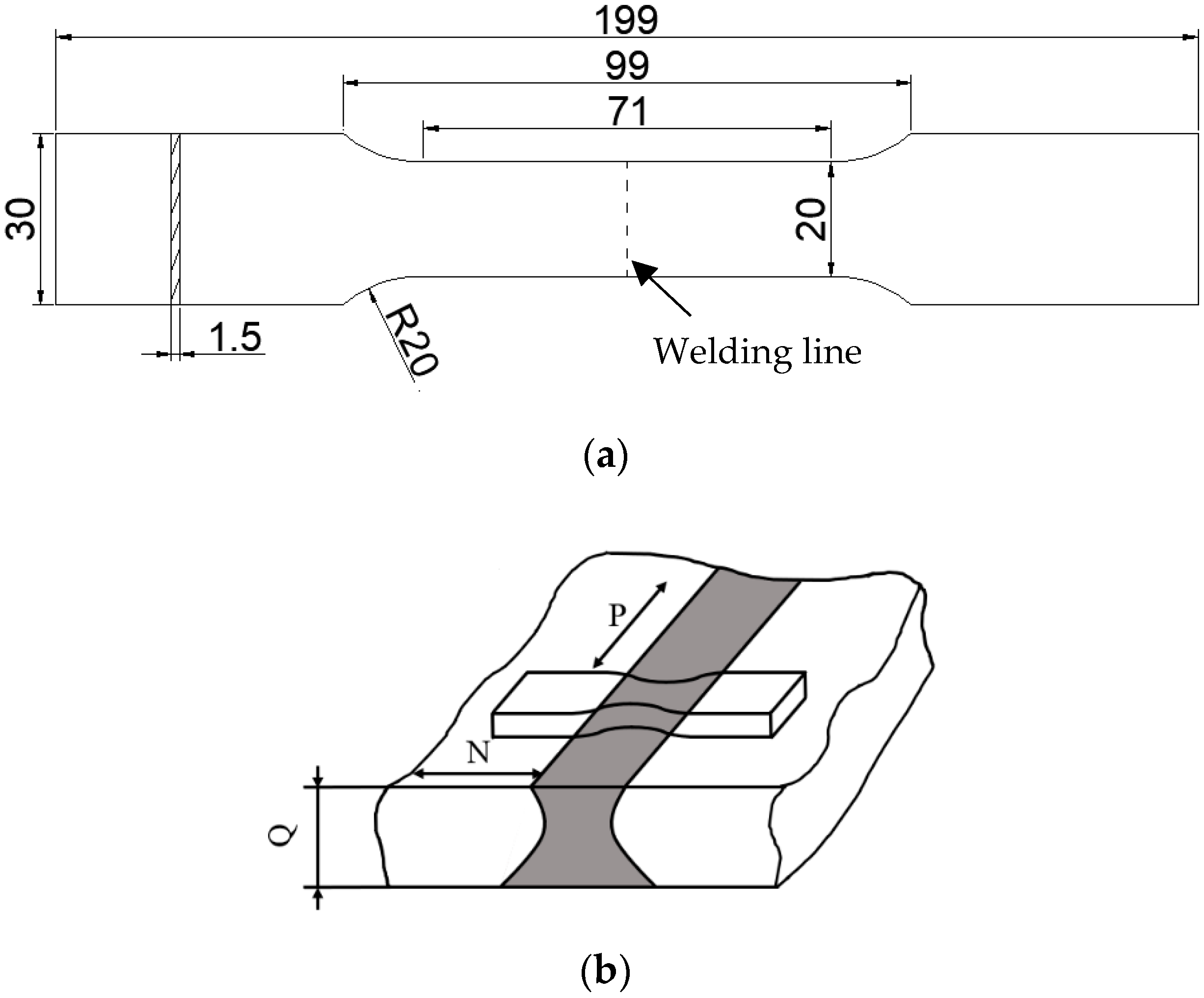


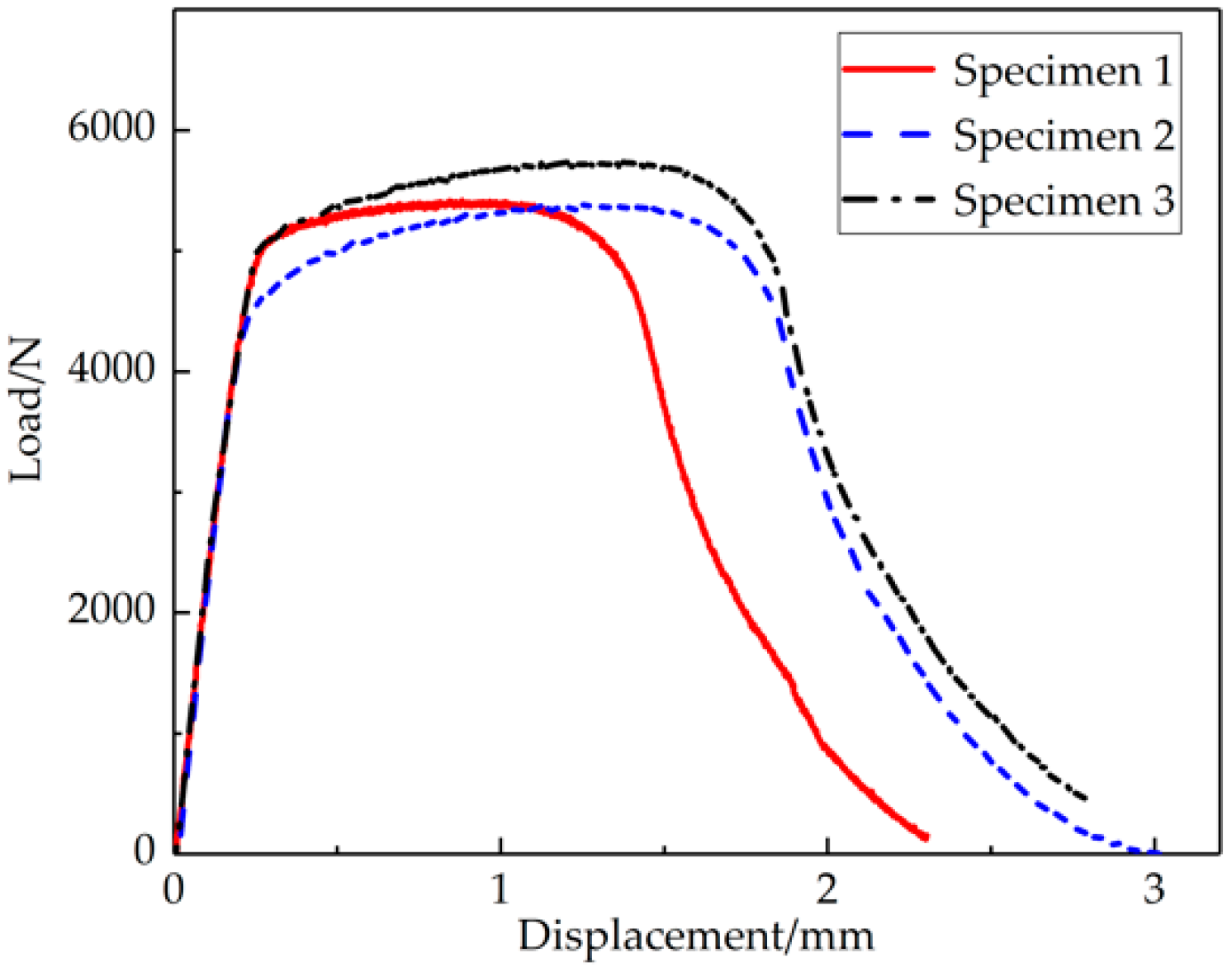
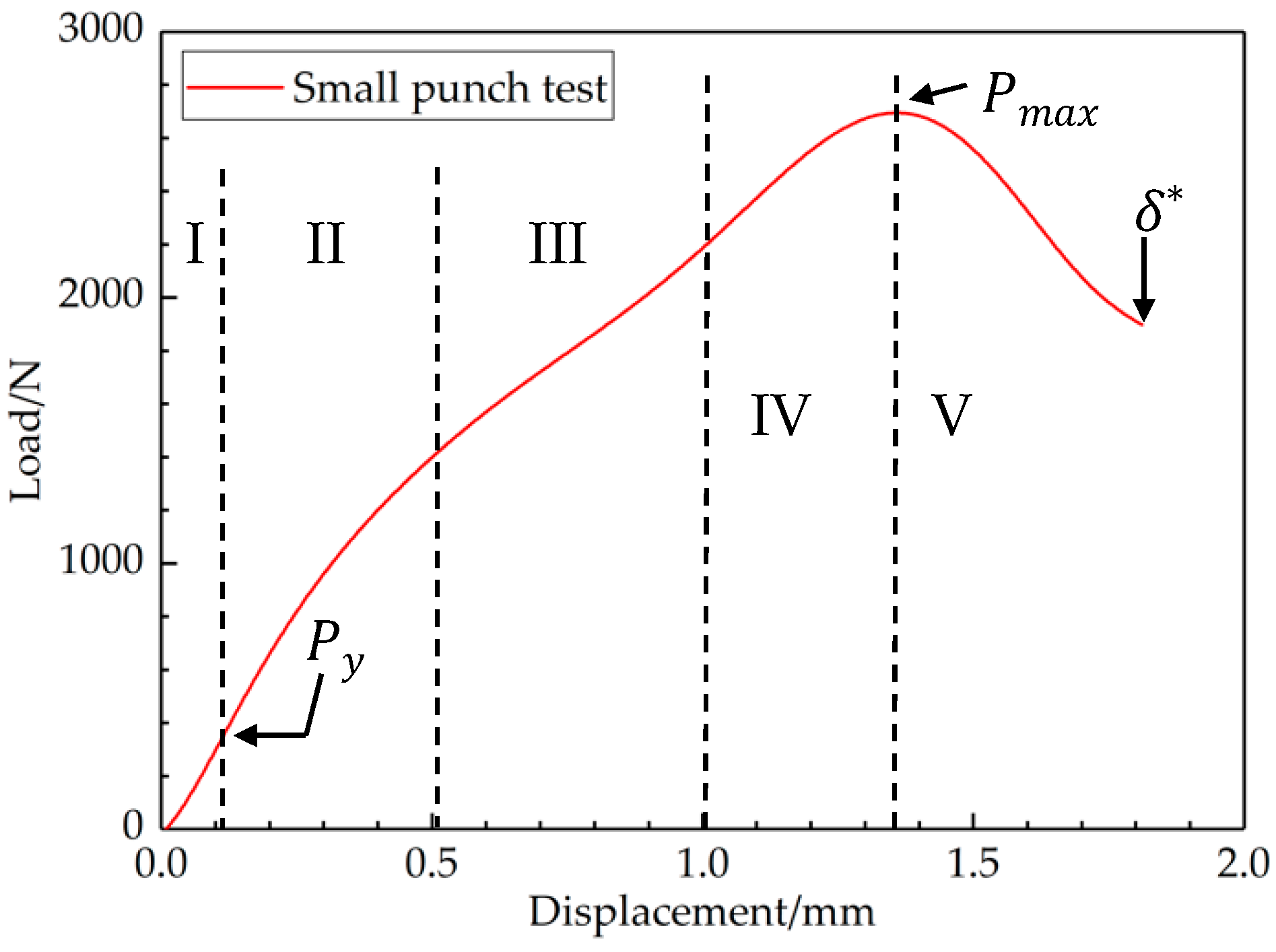
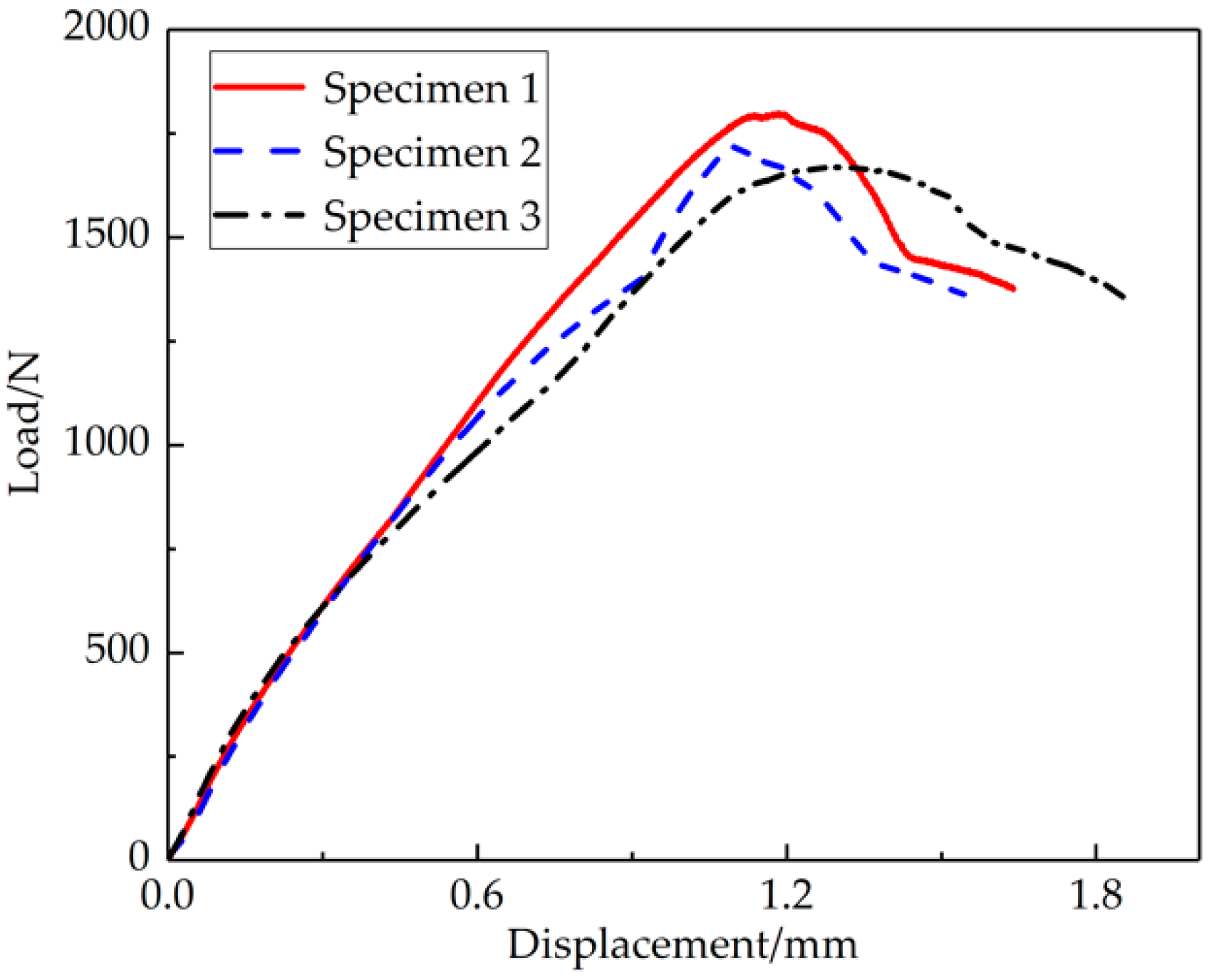


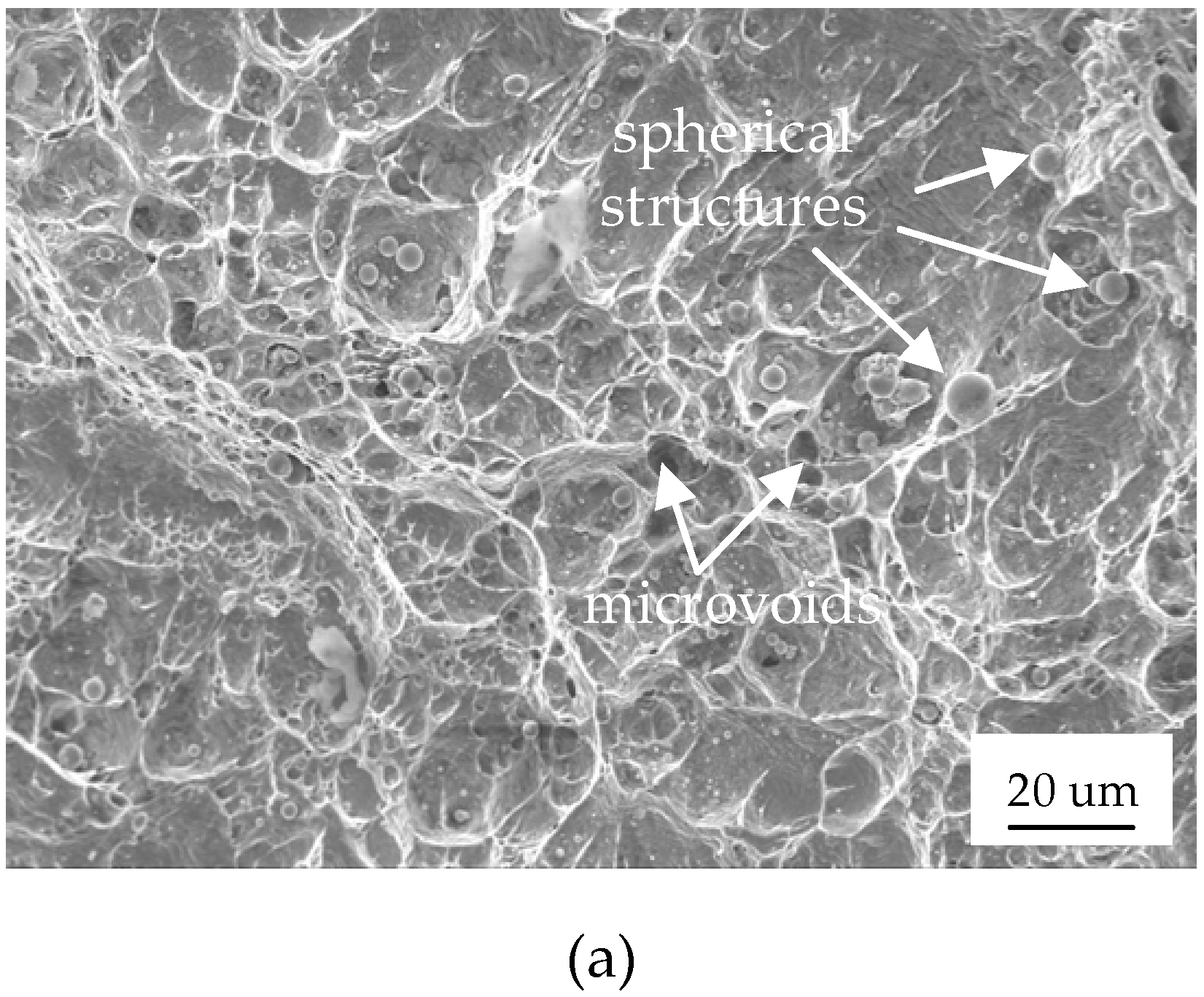
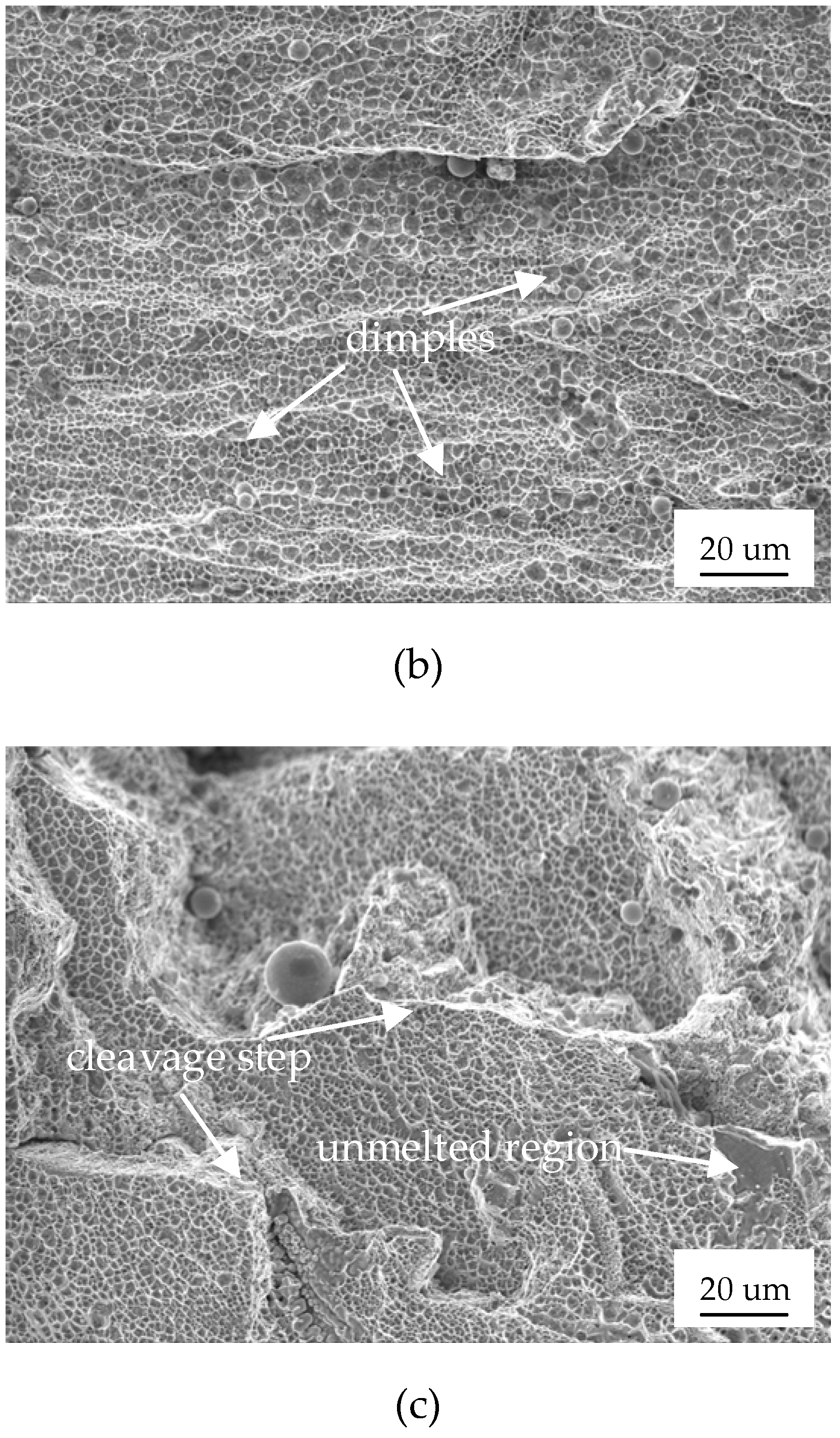

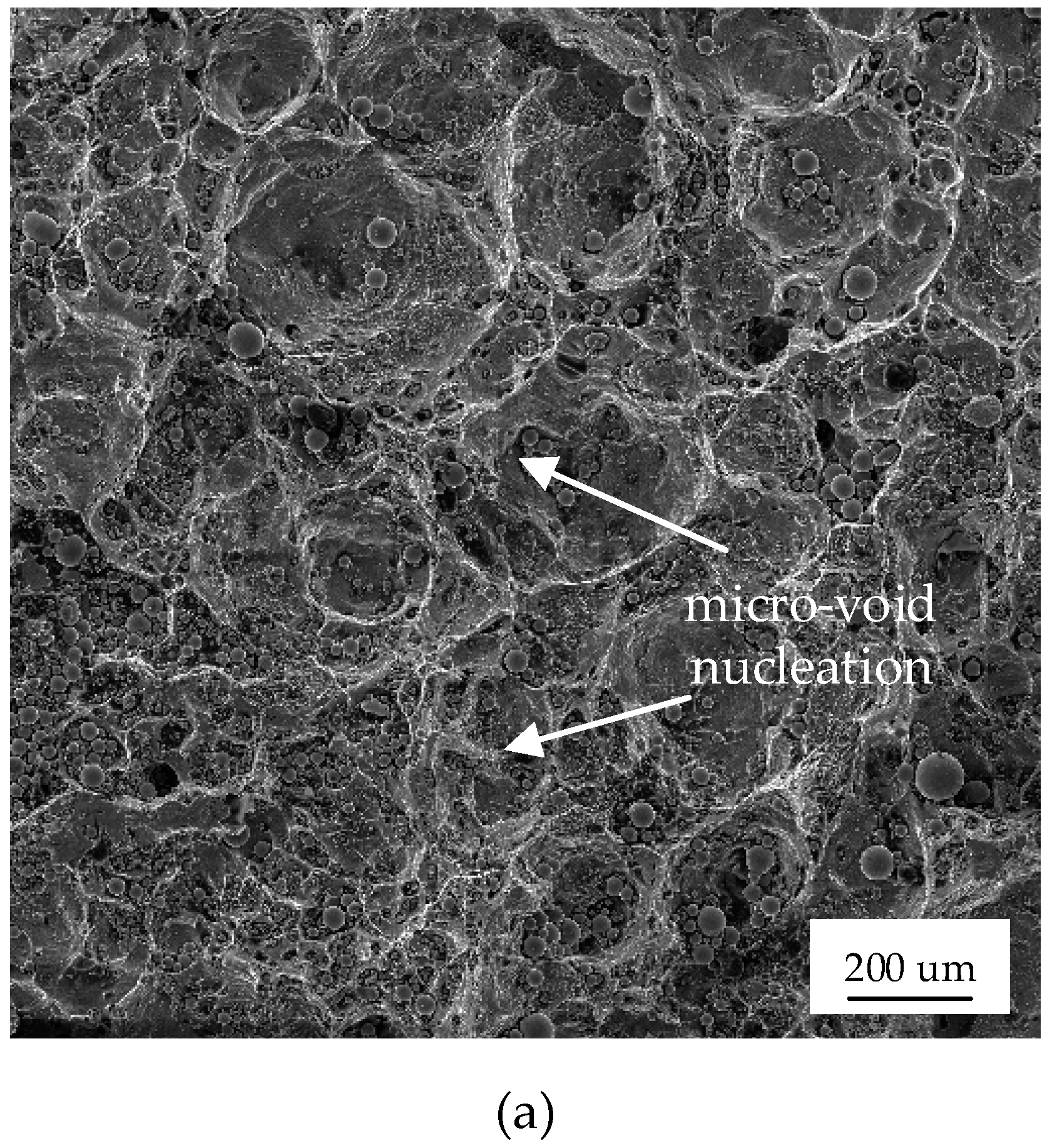
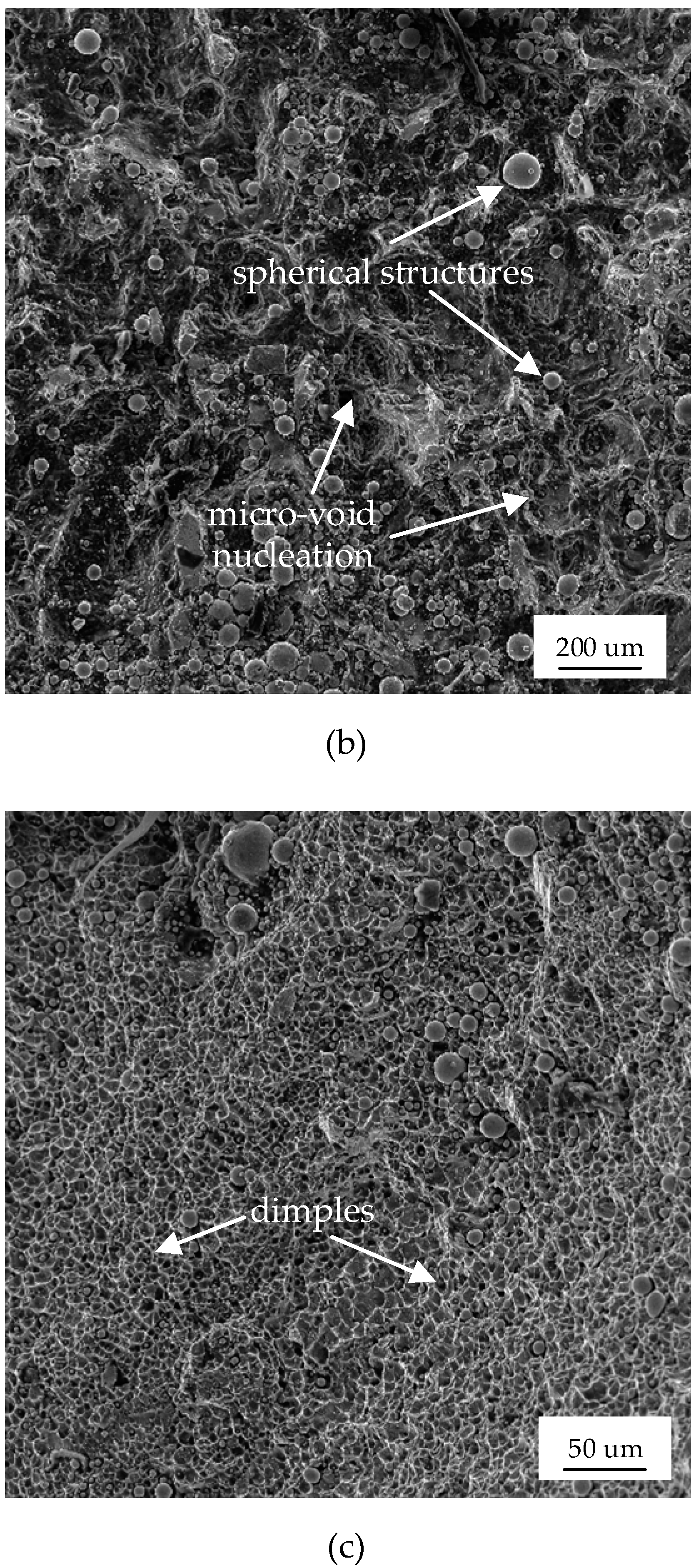


| Material | Cu + Ag | Pb | Fe | Sb | S | As | Bi | Other |
|---|---|---|---|---|---|---|---|---|
| T2 copper | 99.9 | 0.005 | 0.005 | 0.002 | 0.005 | 0.002 | 0.001 | 0.1 |
| Material | C | Si | Mn | P | S | Cr | Ni | Cu |
|---|---|---|---|---|---|---|---|---|
| 45 steel | 0.42–0.50 | 0.17–0.37 | 0.50–0.80 | 0.035 | 0.035 | 0.25 | 0.25 | 0.25 |
| No. | Yield Stress (MPa) | Ultimate Tensile Stress (MPa) | Young’s Modulus (GPa) |
|---|---|---|---|
| 1 | 229.03 | 262.51 | 169.24 |
| 2 | 257.24 | 270.76 | 178.69 |
| 3 | 236.51 | 269.34 | 174.90 |
| Average | 240.93 | 267.54 | 174.28 |
| Material | Yield Stress (MPa) | Ultimate Tensile Stress (MPa) | Elongation (%) | Young’s Modulus (GPa) |
|---|---|---|---|---|
| T2 copper | 64.58 | 238.74 | 50 | 115.79 |
| 45 steel | >350 | >600 | >16 | >200 |
| Electron beam welding joint | 240.93 | 267.54 | 6 | 174.28 |
| No. | δ*/mm | Py/kN | Pmax/kN | σy/MPa | σUTS/MPa | JIC/KJ·m−2 |
|---|---|---|---|---|---|---|
| 1 | 1.639 | 0.149 | 1.797 | 214.56 | 614.44 | 199.266 |
| 2 | 1.566 | 0.145 | 1.720 | 208.8 | 574.4 | 182.889 |
| 3 | 1.856 | 0.153 | 1.671 | 220.32 | 548.4 | 250.325 |
© 2019 by the authors. Licensee MDPI, Basel, Switzerland. This article is an open access article distributed under the terms and conditions of the Creative Commons Attribution (CC BY) license (http://creativecommons.org/licenses/by/4.0/).
Share and Cite
Liu, P.; Bao, J.; Bao, Y. Mechanical Properties and Fracture Behavior of an EBW T2 Copper–45 Steel Joint. Materials 2019, 12, 1714. https://doi.org/10.3390/ma12101714
Liu P, Bao J, Bao Y. Mechanical Properties and Fracture Behavior of an EBW T2 Copper–45 Steel Joint. Materials. 2019; 12(10):1714. https://doi.org/10.3390/ma12101714
Chicago/Turabian StyleLiu, Peng, Jiafeng Bao, and Yumei Bao. 2019. "Mechanical Properties and Fracture Behavior of an EBW T2 Copper–45 Steel Joint" Materials 12, no. 10: 1714. https://doi.org/10.3390/ma12101714
APA StyleLiu, P., Bao, J., & Bao, Y. (2019). Mechanical Properties and Fracture Behavior of an EBW T2 Copper–45 Steel Joint. Materials, 12(10), 1714. https://doi.org/10.3390/ma12101714




